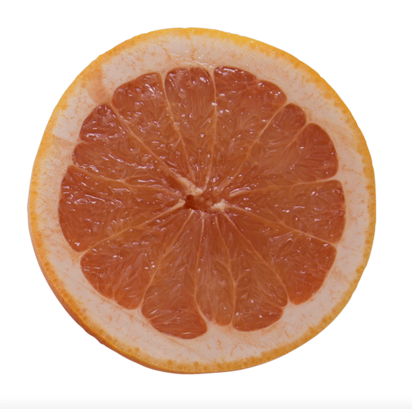Grapefruit: Important Facts, Health Benefits, and Recipes
Explore the health benefits, history, and culinary uses of grapefruit in our ultimate guide, and learn how to incorporate this nutritious citrus powerhouse into your diet.

Nutritional Facts
0.5 medium
Amount per serving
Calories
41
Carbohydrates
10.3 g
Fat
0.1 g
Protein
0.8 g
Saturated Fat
0 g
Sodium
0 mg
Fiber
1.4 g
Sugar
8.9 g
Best Grapefruit Recipes
-

-

-

-

-

-

-

-

-
![Frozen Paloma Cocktails Image]()
-
![Creamy Citrus Smoothie Image]()
-
![Broiled Grapefruit Image]()
-
![Summer Berry Almond Spinach Salad Image]()
-
![Coconut Grapefruit Brulée Image]()
-
![Jingle Bell Punch Image]()
-
![Marinated Hearts of Palm Image]()
-
![Citrus Olive Oil Cake Image]()
-
![Broiled Grapefruit with Honey Yogurt and Granola Image]()
-
![Fizzy Grapefruit Margarita Image]()
-
![Chipotle Grapefruit Margaritas Image]()
-
![Citrus Immunity Shot Image]()
-
![Instant Pot Steel Cut Oats Image]()
-
![Sea Breeze Cocktail Recipe Image]()
-
![Citrus Salad Image]()
-
![Apricot and White Wine Side Porch Sangria Image]()
-
![Grilled Fruit Vegetable Charcuterie Board Image]()
-
![Broiled Grapefruit Recipe Image]()
-
![Radicchio Salad with Citrus Recipe Image]()
-
![Homemade Campari Recipe Image]()
-
![Mojo Marinated Grilled Pork Kebabs Recipe Image]()
-
![Grapefruit Avocado Salad Recipe Image]()
-
![Cuban-Style Roast Pork Recipe Image]()
-
![Grapefruit Margaritas Image]()
-
![Sweet-Tart Candied Citrus Peel Recipe Image]()
-
![All Betts Are Off Recipe Image]()
-
![Beet and Citrus Salad With Pine Nut Vinaigrette Recipe Image]()
-
-
![The Bitter Mimosa Recipe Image]()
-
-
![Tofu and Kale Salad With Avocado, Grapefruit, and Miso-Tahini Dressing Recipe Image]()
-
![Deborah Madison's Two Summer Rhubarb Purées Image]()
-
![DIY Grapefruit Bitters Recipe Image]()
-
![Grapefruit and Ginger Sparkler Recipe Image]()
-
![Extra-Hot Yucatán-Style Roasted-Habanero Salsa (Chile Tamulado) Recipe Image]()
-
![Grapefruit Marmalade Recipe Image]()
-
![Frozen Mezcal Palomas Recipe Image]()
-
![Gluten-Free Grapefruit Cake Recipe Image]()
-
![Granny's Navy Grog Recipe Image]()
-
![The Upgraded Paloma Recipe Image]()















:max_bytes(150000):strip_icc()/sea-breeze-cocktail-recipe-760599-hero-01-74eceed1b89e4c2c9df8ac33aceef19c.jpg)

:max_bytes(150000):strip_icc()/__opt__aboutcom__coeus__resources__content_migration__simply_recipes__uploads__2019__06__Sangria-LEAD-01-5c5b94cc2381446d846f1489c03b7e47.jpg)

:max_bytes(150000):strip_icc()/__opt__aboutcom__coeus__resources__content_migration__simply_recipes__uploads__2014__03__broiled-grapefruit-horiz-a-1600-4d24aa916fde46d38896d7122766632e.jpg)
:max_bytes(150000):strip_icc()/__opt__aboutcom__coeus__resources__content_migration__simply_recipes__uploads__2020__03__Radicchio-Citrus-Salad-LEAD-8-aee99566003941c7a8d7b43f592afb00.jpg)
:max_bytes(150000):strip_icc()/__opt__aboutcom__coeus__resources__content_migration__simply_recipes__uploads__2020__11__Homemade-Campari-LEAD-03-fc10dea61b0643d79eee1ab789d24d7e.jpg)
:max_bytes(150000):strip_icc()/__opt__aboutcom__coeus__resources__content_migration__simply_recipes__uploads__2020__08__Mojo-Pork-Kebabs-LEAD-6-a2e8ef581b1249e7add95045c07956da.jpg)
:max_bytes(150000):strip_icc()/__opt__aboutcom__coeus__resources__content_migration__simply_recipes__uploads__2015__02__grapefruit-avocado-salad-horiz-a-1600-eecae1f6c8d74d4ead940f360e21dec4.jpg)
:max_bytes(150000):strip_icc()/__opt__aboutcom__coeus__resources__content_migration__simply_recipes__uploads__2020__01__Mojo-Pork-Shoulder-Lead-4-713577b130bf48a6bc418f8a2b41b56f.jpg)

:max_bytes(150000):strip_icc()/new-candied-citrus-peel-1500-58ae01dd5f9b58a3c90e45aa.jpg)
:max_bytes(150000):strip_icc()/__opt__aboutcom__coeus__resources__content_migration__serious_eats__seriouseats.com__recipes__images__2014__04__20140405-all-betts-are-off-2913a0a2a9044f4092b6969cd629f18a.jpg)
:max_bytes(150000):strip_icc()/__opt__aboutcom__coeus__resources__content_migration__serious_eats__seriouseats.com__recipes__images__2015__12__20120202-beet-grapefruit-orange-pinenut-salad-kenji-7e45a019e85d4c1c930f0f2ced791767.jpg)
:max_bytes(150000):strip_icc()/__opt__aboutcom__coeus__resources__content_migration__serious_eats__seriouseats.com__recipes__images__2015__06__20150618-three-ingredient-cocktails-bitter-mimosa-vicky-wasik-a2252908e97049ed81cfbbea19a6fb38.jpg)
:max_bytes(150000):strip_icc()/20230418-SEA-Tofu-and-Kale-Salad-With-Avocado-Grapefruit-and-Miso-Tahini-Dressing-00533-VictorProtasio-e748bf8e237047a4a869dd210e7657d9.jpg)

:max_bytes(150000):strip_icc()/__opt__aboutcom__coeus__resources__content_migration__serious_eats__seriouseats.com__recipes__images__2013__02__DIYgrapefruitbitters-a8c0c066f3e3459bbe0d91c6019af4dc.jpg)
:max_bytes(150000):strip_icc()/__opt__aboutcom__coeus__resources__content_migration__serious_eats__seriouseats.com__recipes__images__2015__06__20150618-three-ingredient-cocktails-grapefruit-ginger-sparkler-vicky-wasik-ec3260f9bf854c76bc244ac00569a81f.jpg)
:max_bytes(150000):strip_icc()/__opt__aboutcom__coeus__resources__content_migration__serious_eats__seriouseats.com__recipes__images__2016__05__20160507-habanero-salsa-yucatan-09-f47ee8c0a5f7418f8d4e3caf8785444f.jpg)
:max_bytes(150000):strip_icc()/__opt__aboutcom__coeus__resources__content_migration__serious_eats__seriouseats.com__recipes__images__2012__01__20120108-186270-preserved-grapefruit-marmalade-primary-f578522bda1a438fb0e3c9e2cc920be7.jpg)
:max_bytes(150000):strip_icc()/__opt__aboutcom__coeus__resources__content_migration__serious_eats__seriouseats.com__recipes__images__2016__08__20160804-frozen-paloma-cocktail-3-8eab2f402d1d49338931310f51c48337.jpg)
:max_bytes(150000):strip_icc()/__opt__aboutcom__coeus__resources__content_migration__serious_eats__seriouseats.com__recipes__images__2013__01__20130108-235912-GFTues-GrapefruitCakeRecipes-137a6833a9c84008958b95e45c87a15b.jpg)
:max_bytes(150000):strip_icc()/__opt__aboutcom__coeus__resources__content_migration__serious_eats__seriouseats.com__recipes__images__2013__09__20130929-267956-navy-grog-1d6c84138af5467bb0a503e92a03803a.jpg)
:max_bytes(150000):strip_icc()/__opt__aboutcom__coeus__resources__content_migration__serious_eats__seriouseats.com__images__2015__05__20150526-salted-grapefruit-cordial-cocktail-vicky-wasik-1-013e2e67748d4444a92b51ab332880dd.jpg)